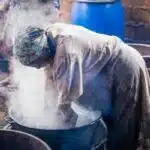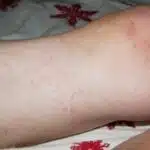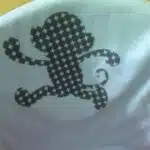Dye stains can be a frustrating and challenging problem for any household. Whether it’s from an accidental spill or a poorly executed DIY coloring project, dye stains can leave clothes looking discolored and unsightly. Fortunately, there are several effective methods to remove these stubborn stains and restore your clothes back to their original color.
As a laundry care expert, I have seen numerous cases of dye stains on clothes. Through years of experience and experimentation, I have compiled a list of tried-and-tested techniques for removing these pesky stains. In this article, I will share with you some of the most effective methods that you can use to remove dye stains from clothes. With my tips and tricks, you’ll be able to tackle even the toughest dye stains with confidence and ease.
Types Of Dye Stains
Have you ever experienced the frustration of dye stains on your clothes? Differentiating between permanent and non-permanent dye stains is crucial in determining the best approach for removal. Permanent dye stains are those that have been chemically processed, such as hair dyes or clothing dyes that have been set with heat. Non-permanent dye stains come from sources such as food coloring or markers and can often be removed with common household items.
Common sources of dye stains include: red wine, coffee, tea, berries, and ink. These stains can quickly become permanent if not treated promptly and correctly. It is important to identify the source of the stain to determine the appropriate course of action for removal.
When dealing with any type of dye stain, it is essential to act quickly. The longer a stain sits on fabric, the more difficult it becomes to remove. In the next section, we will discuss how to prepare your clothes for stain removal to ensure maximum effectiveness in removing unwanted dye stains.
Preparing Your Clothes For Stain Removal
Now that we know the different types of dye stains, it’s time to prepare our clothes for stain removal. Pre-treatment techniques are essential in removing dye stains effectively. Before applying any cleaning solution, make sure to read the label and test it on a small, inconspicuous area of the garment first.
Once you’ve determined that the cleaning solution is safe to use on your clothes, it’s time to gather all the necessary stain removal equipment. You’ll need a clean white cloth or paper towels, a bowl of cold water, a stain remover (preferably one specifically designed for removing dye stains), and a laundry brush.
To begin with, remove any excess dye by blotting the stain with a clean white cloth or paper towel. Do not rub as this might spread the stain further. Next, apply your chosen stain remover directly onto the affected area and let it sit for about 5-10 minutes. Follow up by rubbing gently with a laundry brush in circular motions.
Incorporate these pre-treatment techniques and use the right equipment for efficient and effective dye stain removal. Remember also to spot test your cleaning solution before applying them onto your clothes to avoid any unwanted damage or discoloration.
Spot Testing Your Cleaning Solution
Before attempting to remove a dye stain from your clothes, it is important to spot test the cleaning solution that you plan to use. This step is crucial as it allows you to determine whether the cleaning solution will work on your fabric without causing any damage. Spot testing involves applying a small amount of the cleaning solution onto an inconspicuous area of the fabric and checking for any adverse reactions.
Skipping the spot testing step can potentially result in irreversible damage to your clothes. Some fabrics are delicate and may not react well to certain chemicals or solutions, resulting in discoloration or even holes in the fabric. Additionally, some dyes are more resistant than others and may require stronger cleaning agents that can cause damage if not used correctly. Therefore, taking the time to spot test ensures that you do not cause further damage while attempting to remove a stain.
In conclusion, spot testing your cleaning solution is an important step that should not be skipped when attempting to remove dye stains from your clothes. Doing so ensures that you do not cause further damage and increases the chances of successfully removing the stain without compromising the quality of your clothes. With this in mind, let us proceed with one of the methods for removing dye stains: using vinegar and baking soda.
Method 1: Using Vinegar And Baking Soda
- To remove dye stains from clothes using vinegar and baking soda, start by gently dabbing the stained area with a cloth soaked in warm water and vinegar.
- Then, mix baking soda and water together to form a paste, and apply directly to the stain.
- Leave the paste on the stain for around 15 minutes and then rinse off with cold water.
- Utilizing vinegar and baking soda to remove dye stains from clothes is a cost-efficient and effective method that can be used on a variety of fabrics.
Steps To Remove Dye Stains Using Vinegar And Baking Soda
To effectively remove dye stains from clothes using vinegar and baking soda, there are certain steps that need to be followed. Firstly, mix equal parts of white vinegar and water in a bowl. Soak the stained clothes in this solution for about an hour. This will help to loosen the dye pigment from the fabric. Alternatively, you can pour the solution directly onto the stain and let it sit for 30 minutes before washing.
Next, make a paste by mixing baking soda with water until it forms a thick consistency. Apply this paste directly onto the stained area of the garment and let it sit for at least 30 minutes before washing. The baking soda helps to absorb any remaining dye pigment that was not removed by the vinegar solution.
Although this method is effective in removing dye stains, there are alternative solutions available as well. For example, using commercial stain removers or seeking professional cleaning services may also work in removing stubborn dye stains. However, it’s important to note that using vinegar and baking soda may not work on all types of fabrics or dyes. There’s also a potential risk of fading or discolouring the fabric if left for too long or used on delicate materials. Therefore, it’s advisable to test a small area first before applying the solution to larger areas of the garment.
Benefits Of Using Vinegar And Baking Soda
When it comes to removing stubborn dye stains from clothes, using vinegar and baking soda can be a simple and effective solution. In addition to being readily available in most households, these two ingredients have proven to be cost-effective and eco-friendly compared to other commercial stain removers. Moreover, vinegar and baking soda are gentle on fabrics, making them suitable for use on delicate materials such as silk or wool.
An advantage of using vinegar and baking soda is that they work together to combat the stain from different angles. Vinegar’s acidic properties help loosen the dye pigment from the fabric while also acting as a natural fabric softener. On the other hand, baking soda’s alkaline nature helps break down any remaining dye particles that may be trapped within the fibers of the garment. This dual action makes this method particularly effective in removing stubborn stains that may not respond well to other treatments.
Although there are alternative solutions available for removing dye stains, such as bleach or commercial stain removers, these products may contain harsh chemicals that can damage fabrics or cause fading over time. Compared to these alternatives, vinegar and baking soda provide a safer option for those who prefer natural cleaning methods. However, it’s important to note that effectiveness may vary depending on the type of fabric or dye used in the garment. Therefore, it’s always best to test a small area first before applying any solution on larger areas of the clothing item.
Method 2: Using Hydrogen Peroxide And Dish Soap
The combination of hydrogen peroxide and dish soap is a powerful solution for removing dye stains from clothes. This method is highly effective in breaking down the dye molecules and eliminating them from the fabric. The visual representation of this process can be compared to watching a chemical reaction unfold, as hydrogen peroxide acts as an oxidizing agent and dish soap aids in the emulsification of the dye particles.
To utilize this method, begin by mixing equal parts hydrogen peroxide and dish soap in a small bowl or basin. Apply the solution directly onto the stained area, making sure it covers every part of the stain. Use a clean cloth or brush to gently rub the solution into the fabric, ensuring that it penetrates deep into the fibers. Leave the solution on for about 30 minutes before rinsing with cold water.
While hydrogen peroxide is typically used for stain removal, there are alternatives that can be just as effective. Lemon juice, white vinegar, or baking soda can also be used in place of hydrogen peroxide to remove dye stains from clothes. However, it’s important to note that these alternatives should not be combined with dish soap, as they may react negatively with each other and cause further damage to your clothing.
Moving on to method 3: using bleach (for white clothes only), this is another option for removing tough dye stains from fabrics. However, it should only be used on white clothing items as bleach can cause discoloration or damage when applied to colored fabrics. It’s important to follow specific guidelines when using bleach so that you do not damage your clothing during the process.
Method 3: Using Bleach (For White Clothes Only)
Hydrogen peroxide and dish soap may not work for all dye stains on clothes. In some cases, especially when dealing with white clothes, bleach can be a more effective solution. However, before using bleach, it is important to consider some precautions.
Bleach alternatives should be considered first before resorting to bleach as it can be harsh on clothes and cause damage if not used properly. Hydrogen peroxide and vinegar are some of the alternatives that can help remove dye stains from clothes. These alternatives also work well on colored fabrics and are less damaging than bleach.
When using bleach, always follow the instructions carefully and wear gloves to protect your hands. It is also important to avoid mixing bleach with other cleaning agents such as ammonia or vinegar as this can produce toxic fumes. Additionally, use bleach only on white clothes as it can discolor or damage colored fabrics. After using bleach, rinse the clothes thoroughly with water to remove any residue left behind.
Transition: While hydrogen peroxide and dish soap may work for some dye stains, there are cases where stronger solutions are needed. In the next section, we will explore method 4: using lemon juice and salt to remove stubborn dye stains from clothes.
Method 4: Using Lemon Juice And Salt
As a laundry care expert, I understand how frustrating it can be to accidentally stain your clothes with dye. Luckily, there are several methods for removing these stains. In this section, we will discuss Method 4: Using Lemon Juice and Salt.
To begin, you will need to gather the following items: fresh lemon juice and table salt. Start by mixing equal parts of lemon juice and salt to create a paste. Then, apply the paste directly onto the stained area and let it sit for at least 30 minutes. Afterward, rinse the garment with cool water and repeat the process if necessary.
Alternative solutions for removing dye stains include using vinegar or baking soda mixed with water. However, it is important to note that these methods may not be suitable for all types of fabrics and could potentially damage them. It is always best to spot test any solution on an inconspicuous area of the garment before proceeding.
Safety precautions should also be taken when working with lemon juice as it can cause skin irritation or make your skin more sensitive to sunlight. Be sure to wear gloves when handling lemon juice and avoid exposing yourself to direct sunlight while wearing garments treated with lemon juice.
In the next section, we will discuss Method 5: Using Commercial Stain Removers – a more convenient option for those who prefer not to DIY their laundry solutions.
Method 5: Using Commercial Stain Removers
Commercial stain removers are a great option for removing dye stains from clothes. The best brands of commercial stain removers contain powerful ingredients that can break down and remove even the toughest stains. These products are specially designed to target specific types of stains, including dye stains, and can be very effective when used correctly.
When using a commercial stain remover, it is important to follow all safety precautions. Many stain removers contain harsh chemicals that can be dangerous if ingested or inhaled. Always wear gloves and work in a well-ventilated area when using these products. It is also important to carefully read the instructions on the label before use, as different products may have different application methods and wait times.
Some of the best brands of commercial stain removers for dye stains include Rit Dye Laundry Treatment Stain Remover, Carbona Color Run Remover, and Synthrapol Detergent. These products are specifically formulated to remove dye stains from clothing and other fabrics, and can be very effective when used correctly. When selecting a product, be sure to choose one that is appropriate for the type of fabric you are treating, as some products may not be safe for delicate or sensitive materials.
Transition: While commercial stain removers can be highly effective at removing dye stains from clothes, there are also some simple tips you can follow to improve your chances of success. Read on to learn more about how to effectively remove dye stains from your clothing.
Tips For Effective Stain Removal
Effective stain removal requires proper pre-treatment and the use of appropriate techniques. Pre-treatment options include using a stain remover or applying a mixture of laundry detergent and water directly to the affected area. It is important to treat stains as soon as possible, before they set into the fabric.
DIY stain removal techniques can also be effective for removing dye stains from clothes. One such technique is using vinegar and baking soda. Mix equal parts white vinegar and water, then apply to the stained area with a cloth. Let it sit for 10-15 minutes before rinsing with cold water. Next, mix equal parts baking soda and water to create a paste, then apply to the stain and let it sit for another 10-15 minutes before rinsing again with cold water.
By following these tips for effective stain removal, you can successfully remove dye stains from clothes without damaging the fabric. In the next section, we will discuss common mistakes to avoid when attempting to remove stains at home.
Avoiding Common Stain Removal Mistakes
Common mistakes in stain removal can cause irreversible damage to your clothes. It is crucial to avoid these mistakes if you want to keep your clothes looking great. One common mistake is using hot water on stains, which can set them into the fabric permanently. Another mistake is rubbing the stain vigorously, which can spread the dye and make it harder to remove. Lastly, using too much detergent or bleach can weaken the fabric and fade the color.
To ensure effective stain removal, it is best to follow some basic practices. Firstly, act quickly and don’t let stains sit for too long before treating them. Secondly, always test any stain removal solution on an inconspicuous area before applying it to the entire garment. And finally, wash clothes in cold water as much as possible, as this will help prevent dye bleeding and fading.
By following these best practices for stain removal, you can save yourself time and money by avoiding common mistakes that could ruin your clothes. Remember that prevention is always better than cure when it comes to laundry care, so take care of your clothes by practicing good stain removal habits and preventing dye stains in the future.
Preventing Dye Stains In The Future
Avoiding Common Stain Removal Mistakes is crucial in maintaining the quality and appearance of our clothes. However, even with preventive measures, dye stains can still happen. In this section, we will discuss some long-term solutions to prevent dye stains in the future.
One effective way to prevent dye stains is by separating dark-colored clothing from light-colored ones when doing laundry. This method can be done by sorting clothes according to color before washing them. Separating clothes helps avoid color bleeding, especially when using a washing machine that uses water to wash clothes. Additionally, it would be best if you used cold water for darker clothes as hot water tends to cause colors to bleed.
Another preventive measure you can do is by treating new clothes before wearing them. New clothes tend to bleed or transfer their color onto other fabrics during the first few washes. To avoid this, soak new clothing in saltwater or vinegar solution before washing them for the first time. Doing so will help set the dyes and reduce the chances of color bleeding.
Preventing Dye Stains in the Future is essential in maintaining our clothes’ quality and appearance. By following these long-term solutions, we can avoid having unsightly dye stains on our favorite garments and preserve their beauty for longer periods.
Handling Stubborn Or Set-In Stains
Did you know that approximately 3 out of 4 people experience stubborn or set-in stains on their clothes? These stains can be caused by a variety of factors, such as grease, oil, or ink. If left untreated, these stains can become more difficult to remove over time. Dealing with stubborn stains requires patience and the right techniques.
Tips and tricks for handling stubborn stains include using a pre-treatment stain remover before washing the garment, soaking the stained area in a mixture of water and detergent for several hours or overnight, and using a laundry brush to gently scrub the stain. However, it is important to avoid common mistakes such as using hot water on protein-based stains like blood or sweat, which can cause them to set even further into the fabric.
If you have tried multiple methods but still cannot remove the stubborn stain, it may be time to seek professional help. A professional cleaner has access to specialized equipment and solutions that can effectively remove even the toughest of stains without damaging your clothes. Remember that seeking professional help should always be a last resort after attempting various home remedies.
Seeking Professional Help
Handling stubborn or set-in stains can be frustrating, especially when it comes to dye stains. However, there are various methods that you can use to remove them from your clothes. As discussed earlier, one option is to use a color remover product, which is effective but may also cause damage to the fabric. Another method is to use a mixture of vinegar and baking soda, which is a gentler alternative but may require multiple applications.
If you have attempted these methods and still cannot remove the dye stain from your clothes, seeking professional help may be the best option for you. There are pros and cons to this approach that you should consider before making a decision. On one hand, professional cleaners have access to industrial-strength products and equipment that can effectively remove even the most stubborn stains. On the other hand, this service can be costly compared to DIY methods.
When considering whether or not to seek professional help for dye stain removal, it’s important to weigh the cost comparison against the potential benefits or drawbacks of each option. Additionally, keep in mind that caring for your clothes after stain removal is equally important in maintaining their quality and longevity. In the next section, we will discuss tips on how to properly care for your clothes once you have successfully removed any stains.
Caring For Your Clothes After Stain Removal
After stain removal, it is important to ensure that clothes are dried properly to avoid any further damage. Ironing the garment can help to remove any creasing caused by washing and also help to set the stain removal treatment. Washing the clothe in a color-protecting detergent can help to reduce the risk of the stain re-appearing. Storing the garment correctly, either by properly hanging, air-drying or using a stain repellent product can help to prevent further staining.
Drying
Drying your clothes after removing dye stains is a crucial step in caring for them. One important tip to prevent shrinkage is to avoid drying clothes on high heat. High heat can cause the fibers to shrink, leading to misshapen or smaller garments. Instead, opt for air-drying or using lower heat settings on your dryer.
Another important consideration when drying clothes that have had dye stains removed is avoiding color fading. To prevent this, turn dark-colored items inside out before placing them in the dryer. This will help protect the surface of the fabric and reduce friction that can fade colors. Additionally, it’s best to dry similar colored items together and avoid overloading the dryer. Overcrowding can lead to uneven drying and damage to the fabric.
In conclusion, proper drying techniques are essential for maintaining the appearance and longevity of your clothes after removing dye stains. By preventing shrinkage and color fading through careful attention to heat levels, turning items inside out, and separating laundry by color, you can ensure that your wardrobe stays looking fresh and vibrant for longer periods of time.
Ironing
After removing dye stains from your clothes, the next step is to iron them properly. Ironing helps remove wrinkles and creases, making your clothes look neat and presentable. However, it is essential to use the right ironing techniques and tools to avoid damaging your clothes.
When ironing, it is important to set the appropriate temperature based on the fabric type. Different fabrics require different heat levels to prevent scorching or burning. You can refer to the care label on your garment for guidance on the appropriate heat level. Additionally, ensure that you use a clean ironing board and cover to prevent dirt or debris from transferring onto your clothes.
Aside from temperature regulation, you also need to choose the right ironing tools and equipment. For instance, using a steam iron can help remove stubborn wrinkles with less effort than a dry iron. Also, consider using an iron with a non-stick soleplate or spraying starch onto your clothes before ironing for a smoother finish.
Properly caring for your clothes after removing dye stains involves more than just washing them off. Ensuring that you also use proper ironing techniques and tools will keep your clothes looking their best for longer periods of time. So remember always to check the fabric type before setting up your equipment and choosing between steam or dry irons for an efficient result.
Final Thoughts And Recap
In order to maintain the longevity and appearance of your clothes, it is important to treat dye stains as soon as possible. The longer a stain sits, the harder it will be to remove. If you notice a dye stain on your clothing, act quickly by rinsing the affected area with cold water. This will help to prevent the dye from setting in further.
Dealing with multiple dye stains can be overwhelming, but don’t panic. Treat each stain individually, starting with the lightest colored fabric first. Always test any cleaning solution on a small and inconspicuous area before applying it to the stain. If you are unsure about how to proceed or if the stain is particularly stubborn, seek professional help from a reputable dry cleaner.
In summary, removing dye stains from clothes requires swift action and attention to detail. It is important to act fast and treat each stain individually in order to achieve the best results. By following these tips and seeking professional help when necessary, you can keep your clothes looking their best for years to come.
Conclusion
Dye stains on clothes can be frustrating to deal with, but with the right methods and products, they can be removed. There are different types of dye stains such as oil-based dyes and water-based dyes that require specific treatments. Before attempting to remove a stain, it is important to prepare your clothes for the process by checking for instructions on the fabric care label.
Spot testing a cleaning solution is crucial to prevent further damage or discoloration of the fabric. Vinegar and baking soda or hydrogen peroxide and dish soap are two effective methods to remove dye stains. However, stubborn or set-in stains may require professional help.
It is essential to care for your clothes after removing a stain by washing them properly and avoiding exposure to direct sunlight. As a laundry care expert, I understand that some may hesitate to attempt stain removal themselves due to fear of damaging their garments further. However, following these steps can ensure successful stain removal without causing harm to your clothing. Don’t let dye stains ruin your favorite outfit- take action and restore its original beauty!
Image Credits
- “Montage of Molgula occidentalis and Ciona intestinalis embryos stained with fluorescent phalloidin conjugate and DAPI nuclear dye” by eLife – the journal (featured)





























